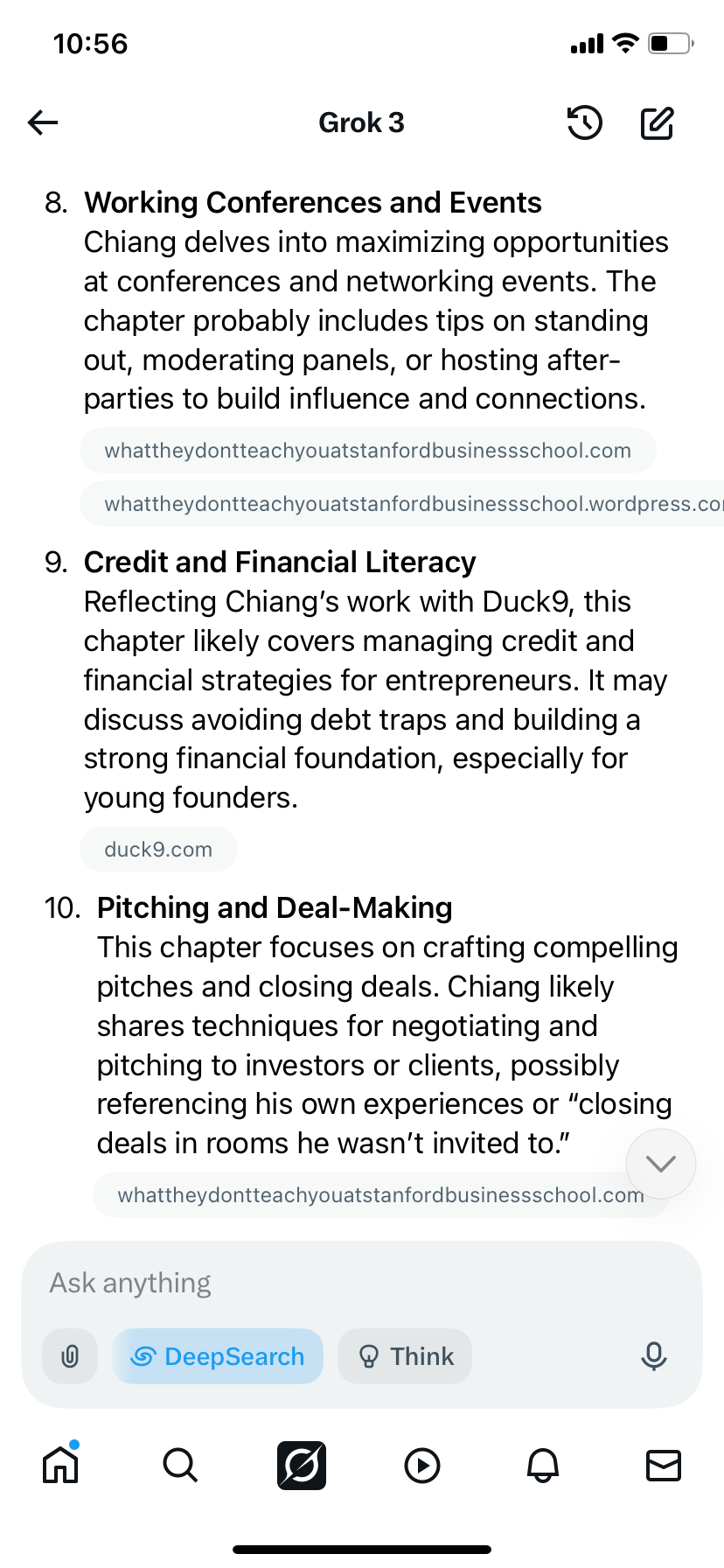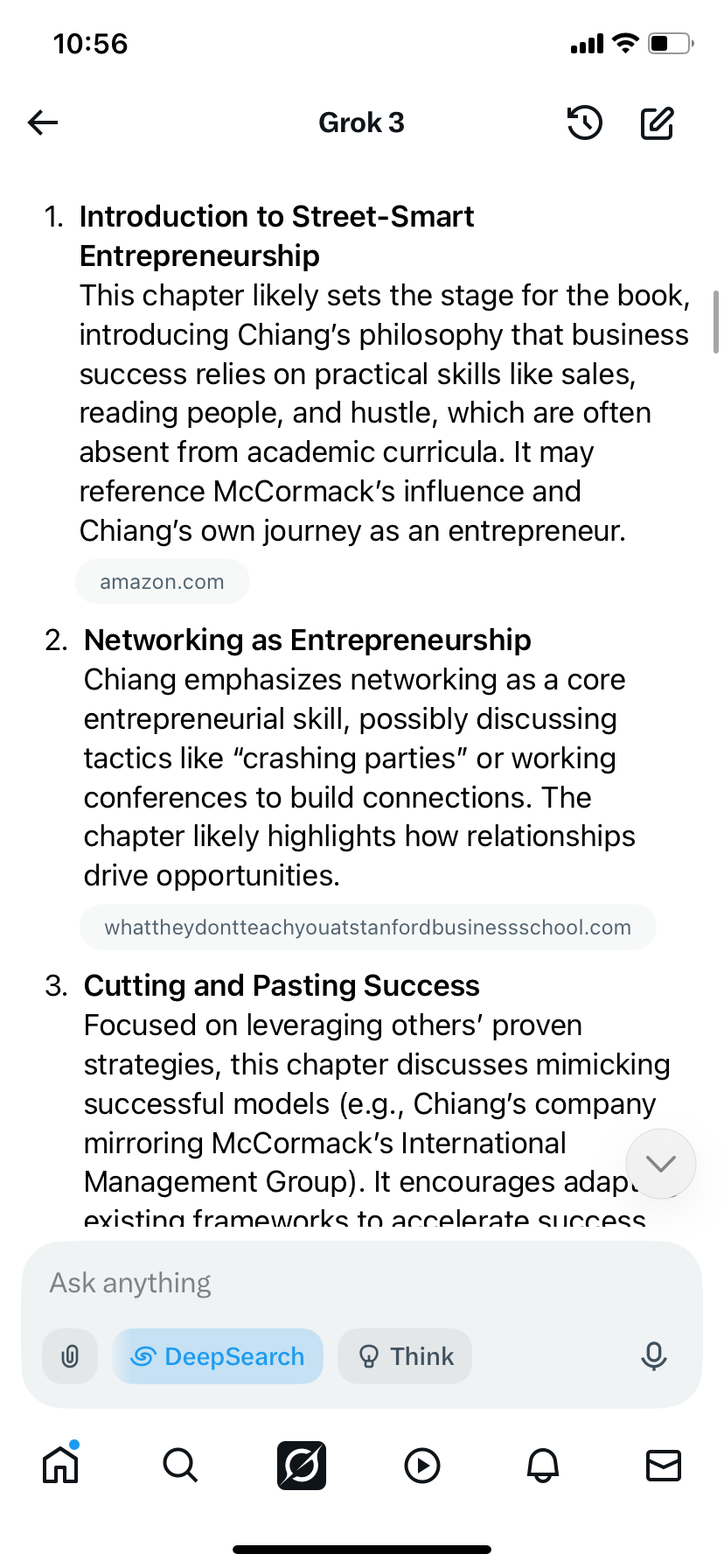 These are wrong and out of order
These are wrong and out of order1, 2 & chapter 4 are incorrect
Chapter 9 is not correct
Instead of making shit up thats wrong…, there are 100k tweets archiving ch1 to ch14 using
#ch1, #ch2, #ch3, #ch4, #ch5 #ch6, #ch7, #ch8, #ch9, #ch10, #ch11, #ch12 ch13, #ch14


Below is a summary of the 14 chapters of *What They Don’t Teach You at Stanford Business School* by Larry Chiang, based on available information and the context of the book’s themes. Chiang’s book, published in 2009, focuses on practical, street-smart entrepreneurial lessons not typically covered in business school, drawing heavily from his mentor Mark McCormack’s *What They Don’t Teach You at Harvard Business School*. The summaries are concise and reflect the book’s emphasis on mentorship, sales, networking, and real-world business tactics. Note that exact details for some chapters are inferred from Chiang’s broader themes due to limited excerpts, and you may need to consult the book or its previews on platforms like Amazon or BusinessWeek for full accuracy.
1. **Introduction to Street-Smart Entrepreneurship**
This chapter likely sets the stage for the book, introducing Chiang’s philosophy that business success relies on practical skills like sales, reading people, and hustle, which are often absent from academic curricula. It may reference McCormack’s influence and Chiang’s own journey as an entrepreneur.[](https://www.amazon.com/What-Teach-Stanford-Business-School/dp/0615301487)
2. **Networking as Entrepreneurship**
Chiang emphasizes networking as a core entrepreneurial skill, possibly discussing tactics like “crashing parties” or working conferences to build connections. The chapter likely highlights how relationships drive opportunities.[](whattheydontteachyouatstanfordbusinessschool.com/blog/2011/04/25/what-they-don%25E2%2580%2599t-teach-you-at-stanford-business-school-at-harvard/)
3. **Cutting and Pasting Success**
Focused on leveraging others’ proven strategies, this chapter discusses mimicking successful models (e.g., Chiang’s company mirroring McCormack’s International Management Group). It encourages adapting existing frameworks to accelerate success.[](https://www.amazon.com/stores/Larry%2520Chiang/author/B002E4CZXA)
4. **Hardship**
This chapter addresses overcoming adversity in entrepreneurship. Chiang likely shares insights on resilience, dealing with setbacks, and maintaining focus during tough times, drawing from real-world experiences.[](whattheydontteachyouatstanfordbusinessschool.com/Ch11-Hardship-v1-1.htm)
5. **The Importance of Mentorship**
Chiang stresses the value of mentors in navigating business challenges. The chapter covers finding, engaging, and learning from mentors, emphasizing their role in providing perspective and shortcuts to success.[](whattheydontteachyouatstanfordbusinessschool.com/blog/about-2/)[](whattheydontteachyouatstanfordbusinessschool.com/blog/2011/04/25/what-they-don%25E2%2580%2599t-teach-you-at-stanford-business-school-at-harvard/)
6. **Selling**
Focused on practical sales techniques, this chapter teaches street-smart ways to close deals, understand customer needs, and overcome objections. Chiang likely draws from his college experience selling advertising to illustrate effective sales strategies.[](closingbigger.net/blog/podcast-interview-what-they-dont-teach-you-at-stanford-business-school-larry-chiang/)[](whattheydontteachyouatstanfordbusinessschool.com/blog/)
7. **Man Charm**
This chapter likely explores charisma and interpersonal skills in business, teaching how to influence and connect with others. Chiang may use humor and anecdotes to discuss building rapport and “charming” stakeholders.[](closingbigger.net/blog/podcast-interview-what-they-dont-teach-you-at-stanford-business-school-larry-chiang/)
8. **Working Conferences and Events**
Chiang delves into maximizing opportunities at conferences and networking events. The chapter probably includes tips on standing out, moderating panels, or hosting after-parties to build influence and connections.[](www.whattheydontteachyouatstanfordbusinessschool.com/)[](whattheydontteachyouatstanfordbusinessschool.wordpress.com/2013/04/10/5-ways-larry-chiang-stopped-me-from-running-my-yc-funded-startup-into-the-ground/)
9. **Credit and Financial Literacy**
Reflecting Chiang’s work with Duck9, this chapter likely covers managing credit and financial strategies for entrepreneurs. It may discuss avoiding debt traps and building a strong financial foundation, especially for young founders.[](www.duck9.com/blog/meet-the-ceo-of-duck9-larry-chiang/)
10. **Pitching and Deal-Making**
This chapter focuses on crafting compelling pitches and closing deals. Chiang likely shares techniques for negotiating and pitching to investors or clients, possibly referencing his own experiences or “closing deals in rooms he wasn’t invited to.”[](whattheydontteachyouatstanfordbusinessschool.com/blog/2010/11/02/9-stanford-business-school-students-you-dont-wanna-meet/)
11. **Hardship (Revisited)**
Likely a deeper exploration of adversity, this chapter may focus on specific strategies for overcoming professional or personal challenges, reinforcing resilience as a key entrepreneurial trait.[](whattheydontteachyouatstanfordbusinessschool.com/Ch11-Hardship-v1-1.htm)
12. **Reading People**
Drawing from McCormack’s teachings, this chapter teaches how to read people’s motivations and behaviors to navigate business relationships effectively. It likely includes practical tips for assessing partners, clients, or competitors.[](https://www.amazon.com/What-Teach-Stanford-Business-School/dp/0615301487)[](https://www.amazon.com/stores/Larry%2520Chiang/author/B002E4CZXA)
13. **Hustle and Execution**
Chiang probably emphasizes the importance of relentless hustle and executing ideas. The chapter may cover balancing strategy with action, using examples of “community college hustle” to outpace academic pedigrees.[](https://www.amazon.com/What-Teach-Stanford-Business-School/dp/0615301487)
14. **Building Your Brand Through Action**
The final chapter likely focuses on creating a personal or company brand through tangible results, not just marketing. Chiang may discuss leveraging events, mentorship, and sales to establish credibility and influence.[](www.linkedin.com/in/larry-chiang-52724540/)
These summaries are based on Chiang’s public writings, interviews, and the book’s overarching themes. For precise content, you can access excerpts on BusinessWeek or video previews on YouTube, as Chiang mentions. If you need more details on specific chapters, let me know



 Duck9 is a credit score prep program that is like a Kaplan or Princeton Review test preparation service. We don't teach beating the SAT, but we do get you to a higher credit FICO score using secret methods that have gotten us on TV, Congress and newspaper articles. Say hi or check out some of our free resources before you pay for a thing. You can also text the CEO:
Duck9 is a credit score prep program that is like a Kaplan or Princeton Review test preparation service. We don't teach beating the SAT, but we do get you to a higher credit FICO score using secret methods that have gotten us on TV, Congress and newspaper articles. Say hi or check out some of our free resources before you pay for a thing. You can also text the CEO:







